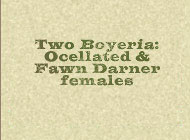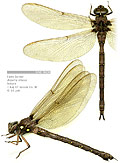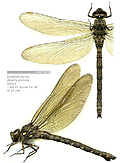
Of the two species of North American Boyeria, I wanted to see the Ocellated Darner, Boyeria grafiana. That's not a big surprise, since the other species, the Fawn Darner, Boyeria vinosa is more common and widespread. Both are restricted to the East. They prefer shaded, rocky streams where they sometimes can be found flying together. The Boyeria are called the spotted darners, having distinctive pale spots on the side of the thorax. In Europe they are called a much cooler name - Spectres. Males patrol low to the water, phantom-like in the shade, carefully examining the shoreline as they go.
I made three attempts in the late summer to collect Ocellated Darner. One morning during the third week in July, I saw a couple of Fawn Darners on the Big Flat Brook in NW New Jersey and thought I might be a little too early in the year for Ocellated.
I tried again on August 7. The morning was cool but a number of Boyeria were flying about. However they all looked to be Fawn Darners, appearing distinctly brown. Ocellated Darners are grayer, a difference which can sometimes be seen in the field. The first Boyeria I caught was indeed a Fawn Darner, a female. By midday, the activity ceased as the temperature rose and I took a break from the stream to look nearby for Somatochloras, Emeralds.
Boyeria are often more active in the late afternoon which was the case when I returned at 3:PM. I slapped my net onto the water to catch one but I was disappointed to see it was yet another Fawn Darner. With the dragonfly in one hand and the sopping wet net in the other, I watched helplessly as a male Ocellated Darner flew slowly by my legs. I had a perfect view looking straight down on him, the more extensive pale markings on the thorax and abdomen were quite distinctive. Although I could not catch him, at least I knew for certain that Ocellated Darners were present.
The Big Flat Brook looks easy enough to wade. It's mostly knee-high shallow and narrow enough to see a dragonfly flying along the opposite shore. You might think you could rush over to the other side in time to get a swing but you would be mistaken. The bottom is covered with various-sized rocks so the footing is uneven. You can painfully stub your toes or step into an unexpected hole and lose your balance. Stepping directly on the rocks is also treacherous. The rocks are big pebbles, rounded and slippery. Needless to say I've ended up on the seat of my pants in the Flat Brook more than once. Easier to pick a side of the stream and wait for the dragonflies to fly by. At least that was my theory but after a long fruitless wait I needed to try a different approach.
I was standing in the stream when another dragonfly went by me. It flew beneath some overhanging branches where I couldn't reach it. I didn't see any brown. As I watched it continue its way upstream, I felt compelled to chase it. Splashing after it in the water was out of the question so I climbed up the bank and started to run. The ground along the stream was pretty clear but I had to hurdle a couple of logs. I ran about a hundred feet then climbed back down the bank. I stepped into the water in time to spot the dragonfly flying towards me in the shadows. As it came by, it surprised me by flying upwards but slowly enough that I could react and catch it. It was a Ocellated Darner and remarkably a female.
Female Ocellated Darners are notoriously hard to find. I've never seen one before and when I first took her out of the net, I mistakenly thought her cerci were short because they had broken off.
Fawn Darner females have much longer cerci. Another difference is wing pattern. Fawn Darners have dark markings at the base of each wing, Ocellated Darners do not.

